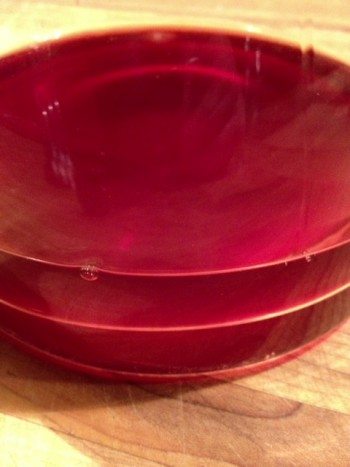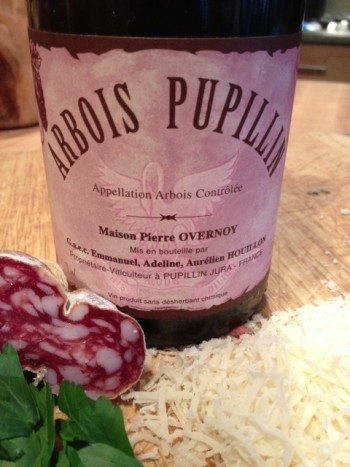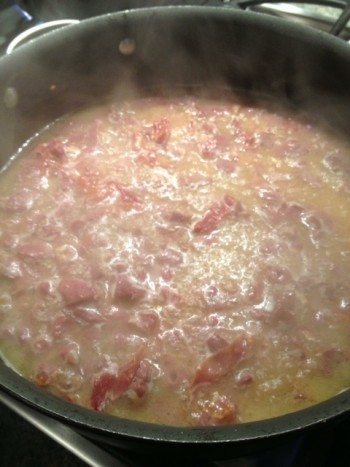Neither this wine nor pasta sauce are regulars on our table. The 2009 Houillon Overnoy Poulsard came via Louis/Dressner from the Jura, specifically Pupillin, where Emmanuel Houillon assumed winemaking duties at Pierre Overnoy’s tiny estate. The pasta sauce relied on “cheater” duck broth and a prosciutto “heel”. The entire meal including prep, cooking, uncorking, decanting, and plating took no more that 20 minutes to prepare following 54 years of regretful oversight.
I have this habit of buying fatty “ends” of Prosciutto di Parma from Russo’s in Watertown, MA. Russo’s is a destination shopping mecca for fresh local vegetables (especially Asian), baked goods, Italian specialties, cheeses, Italian delicatessen, flowers, and so much more epicurean goodness. There is always a half dozen or so of these “ends” laying around and I have no choice beyond taking ownership and cooking with them. I am weakened by a lifetime indoctrination that says cooked “ends” of things taste better than their plenary forms. It could be dogma or imagination, but prosciutto is no exception to the rule.
Our Miele oven is endowed with the gift of rotisserie. I am just about convinced the oven was specifically designed to make perfect Chinese rotisserie duck stuffed and bathed with bean sauce, Shaoxing wine, sugar, five-spice powder, soy sauce, garlic, star anise, and honey. After every piece of flesh is devoured, the carcass is simmered for hours creating an alluring “cheater” broth that I freeze to add a rich asian duck flavor base to anything cooked with it up to several months later.
Chop the prosciutto into 1/2 inch cubes, sauté until browned in one tablespoon of unsalted butter, add one cup of the magic broth, reduce, add 1/4 cup of grated Parmigiano Reggiano cheese, one handful of torn flat leaf parsley, and then mix in one pound cooked pasta while stirring in a teaspoon of freshly ground black pepper until evenly coated.
Plate on something nice and white.
 The dish calls for something red and fresh with enough acidity to stand tall alongside the rich Italian, Asian, peppery, salty flavors. Poulsard grapes’ light skins render pale colored wines and allow its bright fruit to take center stage. The *** $30 2009 Huillon Overnoy version is “naturally” made, unfiltered, and gives up some clarity and brilliance in exchange.
The dish calls for something red and fresh with enough acidity to stand tall alongside the rich Italian, Asian, peppery, salty flavors. Poulsard grapes’ light skins render pale colored wines and allow its bright fruit to take center stage. The *** $30 2009 Huillon Overnoy version is “naturally” made, unfiltered, and gives up some clarity and brilliance in exchange.
 This poulsard was a really good call for the pasta. But, it won’t let you fall in love easily. It is deceptively unique with a light, but not elegant, mouthfeel. It challenges you to appreciate it, yet shows brilliance in its complexity and layered personality. It holds richness without any sense of heaviness, dead-on strawberry/red cherry/cranberry fruits buffeted by citric grapefruit crispiness, dainty qualities while providing a long and riveting finish, roundness despite a chiseled stone profile. The significant acidity from the Franco/Swiss cold weather regional fruit danced with the dish’s peppery spice while the fruit married the Asian spicy sweetness symbiotically. It is an intellectual puzzle that rewards your senses with its liveliness and fruit purity, but challenges you to appreciate just how delicious it is. I wish I saved some for the next day, to see if it might get more comfortable in its own skin.
This poulsard was a really good call for the pasta. But, it won’t let you fall in love easily. It is deceptively unique with a light, but not elegant, mouthfeel. It challenges you to appreciate it, yet shows brilliance in its complexity and layered personality. It holds richness without any sense of heaviness, dead-on strawberry/red cherry/cranberry fruits buffeted by citric grapefruit crispiness, dainty qualities while providing a long and riveting finish, roundness despite a chiseled stone profile. The significant acidity from the Franco/Swiss cold weather regional fruit danced with the dish’s peppery spice while the fruit married the Asian spicy sweetness symbiotically. It is an intellectual puzzle that rewards your senses with its liveliness and fruit purity, but challenges you to appreciate just how delicious it is. I wish I saved some for the next day, to see if it might get more comfortable in its own skin.
 After 54 years and 20 minutes, I am planning to repeat the whole experience in less than seven days. That, in itself, tells me something quite special went on here.
After 54 years and 20 minutes, I am planning to repeat the whole experience in less than seven days. That, in itself, tells me something quite special went on here.
